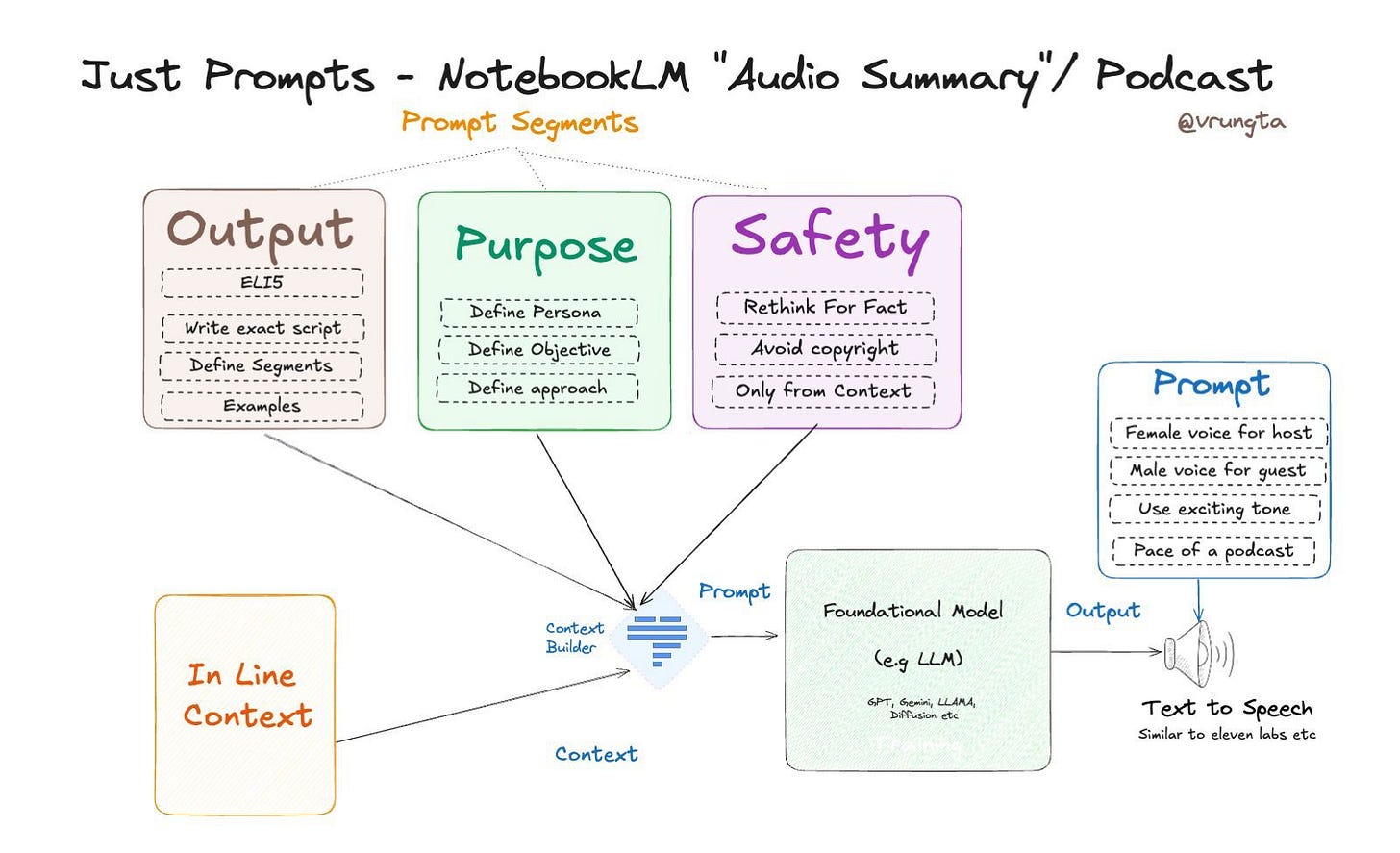Decoding the Architecture of NotebookLM Podcast Feature
Likely architecture of Google's NotebookLM Audio Overview Feature
Last week, we saw an explosion of AI-generated podcasts using Google's NotebookLM, a new tool that turns structured text into engaging audio overviews. This development has sparked conversations about how generative AI can transform content creation. You can read Google's official announcement here.
If you're interested in building something similar, you don’t need to start with complex architectures right away. Instead, you can begin with prompt-based prototypes and then scale up using Retrieval-Augmented Generation (RAG) and data labeling for fine-tuning. This approach not only speeds up the process but also helps you refine your AI model with precision.
Building from the Ground Up: Prompt-Based Prototyping
The easiest way to kickstart your own AI-driven podcast system is by using structured prompts. This method allows you to test and iterate quickly without needing a full-fledged AI infrastructure. Based on the architecture shown in the image below here’s a breakdown of how you can structure your prompts to create a two-person podcast:
Evolving with RAG and Data Labeling for Fine-Tuning
Once your prompt-based prototype is generating reasonably good audio, the next step is to incorporate Retrieval-Augmented Generation (RAG) for more depth and context. This process involves integrating external knowledge sources, making your AI-generated podcasts richer and more informative.
Fine-Tuning Through Data Labeling
The most significant investment in this process will be data labeling, crucial for refining your AI model. Here’s how to approach it:
Analyze Podcasts: Listen to popular podcasts and document key segments like the intro, main discussion, transitions, and conclusion. Label these sections clearly to guide your AI.
Identify Themes: For podcasts that discuss specific topics, tag the sections according to the main hypothesis, supporting arguments, and counterpoints.
Hypothesis Construction: Document how hosts set up the core arguments and how guests respond, noting the flow of conversation.
Data labeling will guide the AI in producing content that not only mimics but enhances the natural flow of human dialogue in podcasts.
I am skipping broader details like LLM security and scaling concerns, as they are not specific to this architecture and should be always a consideration.
Conclusion
The key takeaway from building a product like NotebookLM is that you don’t need to reinvent the wheel. Starting with prompt-based prototypes allows you to iterate quickly, and integrating RAG with precise data labeling takes your AI from basic to brilliant. The architecture outlined in the diagrams provides a straightforward roadmap for anyone looking to turn text into high-quality podcasts. With prompt engineering and a focus on data labeling, creating AI-driven content has never been more accessible.
Demo - NotebookLM
This is what I generated with NotebookLM for this article - don’t quite like the things that I focused on, but this article is about the architecture - so listen in.
Appendix: Hands on building this based on prompt.
The prompts are broken into the following categories:
1. Purpose: Define Persona and Objective
Persona: Imagine you’re a dynamic podcast host, aiming to engage a broad audience interested in AI and technology.
Objective: Your goal is to explain how AI tools like NotebookLM can revolutionize content creation, making it accessible to both experts and beginners.
Approach: Use a conversational and friendly style to break down technical concepts into relatable examples.
2. Safety: Ensuring Accuracy and Contextual Integrity
Rethink for Fact: Cross-check statements to ensure they are factual and based on verified data.
Avoid Copyright: Generate content only from information that is explicitly provided or open-source.
Only from Context: Limit the AI’s responses to rely solely on the data within the current context.
3. Output: Structuring the Podcast Script
ELI5 (Explain Like I’m Five): Simplify complex AI topics to make them easily understandable for all listeners.
Write Exact Script: Create a clear and concise dialogue for a two-person podcast, with distinct roles for the host and guest.
Define Segments: Divide the podcast into three main parts: Introduction, Core Discussion, and Conclusion.
Rethink to Improve: Continuously refine the script based on AI feedback to enhance clarity and engagement.
Here’s a set of ready-to-use prompts for creating your own AI-driven podcast using a two-person dialogue format:
Purpose
Imagine you are the host explaining AI tools in a way that is both engaging and informative.
Your goal is to break down NotebookLM's capabilities for a non-technical audience.
Safety
Ensure all facts presented are accurate and verified.
Avoid using any proprietary or copyrighted material.
Generate responses based only on the provided context.
Output
Simplify AI concepts to make them relatable.
Write a script with two distinct voices: a knowledgeable host and a curious guest.
Structure the podcast into three segments: Introduction, Key Features, and Real-World Applications.
Refine the dialogue to make it as engaging as possible.
Generate a podcast script for me.Demo - Using above prompt + ElevenLabs
I copy pasted exact prompt from above and asked chatgpt to generate podcast for this article. Then took the output script and generated voice from ElevenLabs.




"Hey, thank you so much for sharing this. I really appreciate the time you took to make it understandable. I'm working on a similar project with Spring AI, and this has provided enough insight to define my architecture.